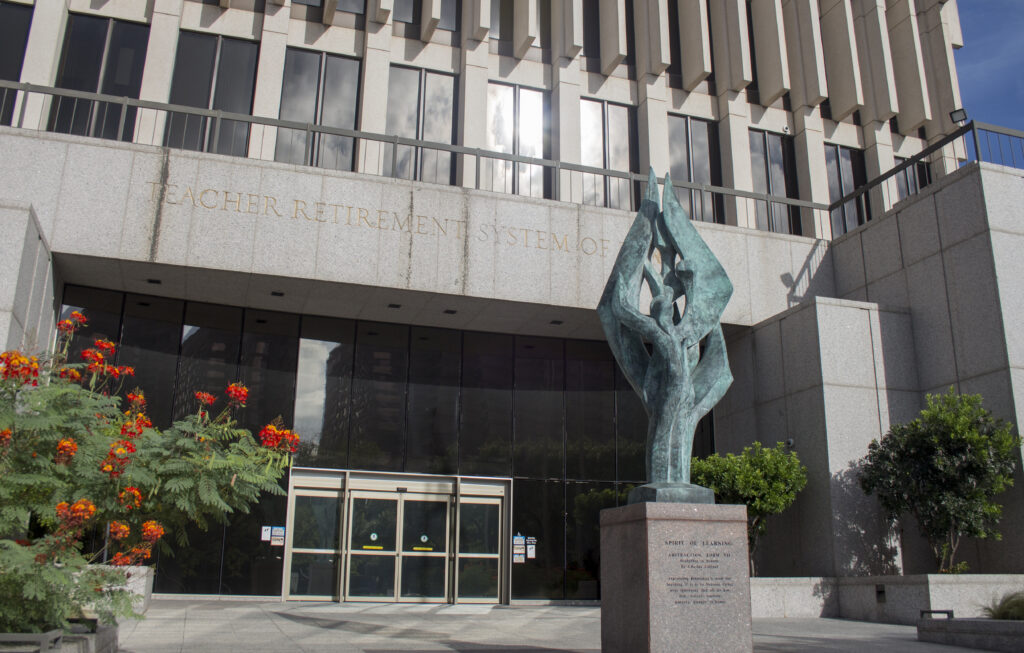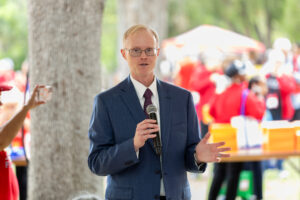The Teacher Retirement System of Texas (TRS) held a Board of Trustees meeting today to discuss the annual actuarial valuation, as well as the implementation of its changes to the retiree health care program, TRS-Care.
The annual actuarial valuation stands as important point for TRS to review and evaluate the pension fund’s performance. The pension fund saw substantial gains this year, with a 12.9 percent growth. The pension fund is ending 2017 with a market value of $147 billion. Last year, that figure stood at $134 billion.
Actuarial Valuation
Joseph Newton, an actuary at Gabriel, Roeder, Smith & Company, made the presentation to the TRS board. He said that the pension fund had “very good results” this year.
“This is about as much good as you can have in one year,” Newton said.
| TRS Trust Fund Valuation | 8/31/17 | 8/31/16 |
| Unfunded Actuarial Accrued Liability | $35.5 Billion | $35.5 Billion |
| Funded Ratio | 80.5% | 79.7% |
| Funding Period | 32.2 years | 33.6 years |
TRS uses an 8 investment rate of return assumption as the benchmark. Each year the fund expects to make an 8 percent return. TRS structures its investments for that purpose. However, when the fund determines the actuarial funding status in the valuation study it does each year, the rate of return is actually subject to a five year average approach called “smoothing.” This process protects against the volatile nature of short-term markets relative to the long-term needs of the pension fund.
The 12.9 percent return this year was offset by two years of not meeting the 8 percent target in the preceding five years, but the fund did end up in a much more positive position than was previously expected. Newton cautioned that the 8 percent actuarial assumption rate might be too high in the current environment and does not “leave a margin for error.”
The current set of actuarial assumptions, which include many different factors besides just rate of return, projects the TRS unfunded liability to be paid off in 32.2 years. According to state statute, TRS can’t provide its retirees with a cost-of-living adjustment unless the unfunded liability has a funding period of less than 30 years. This 32.2-year period beat the actuary’s projection from last year, but it still does not meet the statutory definition of actuarial soundness.
If TRS lowers its rate of return assumption, which the majority of state pensions systems in the nation have done over the last two years, and does not change any other assumptions, it would automatically increase the actuarial unfunded liability period. This would almost certainly mean that payroll contribution rates from the state would have to increase significantly in order to provide a cost-of-living adjustment for retirees in the next session of the Legislature.
As reported yesterday, Tim Lee, TRTA’s Executive Director, addressed this contribution issue with the TRS Board. If the board changes the rate of return assumption, Lee asked them to consider the possibility of seeking additional revenue through state contributions for the pension fund in their 2020-21 legislative appropriations request. These contributions can come from any combination of three sources: Texas educators, school districts or the state.
Newton explained that changing the rate of return assumption would not affect how well the pension fund performs, but it might change how much money the state puts into the pension fund.
Very few of TRS’s peers have a return assumption rate that is 8 percent. The average peer that has done a deep dive evaluation into its pension fund over the last two years has set its rate of return assumption rate at 7.25 percent.
TRTA believes it is important to point out that nearly every state is making a significantly higher contribution to their pension fund. TRS will likely make a decision on whether to change its rate of return assumption rate after an upcoming experience study, which is a deep dive evaluation of the pension fund.
“If the pension trust fund lowers its assumed rate of return, the employer (which TRTA considers to be the state of Texas and the independent school districts) must consider increasing their contribution to the pension fund,” Tim Lee said.
TRTA believes that the Texas constitution requires that the TRS pension fund be managed in an actuarially sound manner, and all parties must work together to maintain its long-term solvency.
To learn more about the actuarial valuation, read the TRS board meeting documents here.
TRS-Care Changes
Due to the increased program funding, the actuary predicted that TRS-Care will remain solvent until 2020. The total number of TRS-Care participants increased by 3.6 percent in 2017, and rose to 274,000 retirees covered.
The amount of communications that TRS is receiving about the health care program began spiking dramatically in the fall. TRS reported that 80 percent of its web traffic since September has been health care related. Similarly, TRS has been experiencing increased call volume relating to health care, and TRS hired a third-party company to help with the calls.
TRS reported that many TRS-Care participants inquired about their health care benefits and the opt-out process. TRS is continuing to craft a communications plan into the future to inform plan participants about the transition to the new health care plans.
If you would like to contact TRTA about your TRS-Care questions, you can send an email to Brock Gregg, TRTA’s Associate Director, at brock@trta.org. Please be sure to provide your name and phone number in your email if you would like a return phone call.
Thank You
The Inside Line is a free service of TRTA, provided to you to keep you informed on current issues and events that impact your life. If you value this service, please consider becoming a member of TRTA by clicking here. If you are already a member, thank you!
Be sure to like us on Facebook, follow us on Twitter and subscribe to our YouTube channel.




